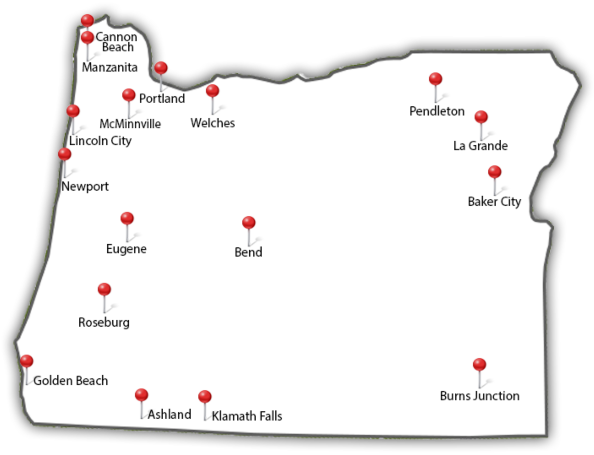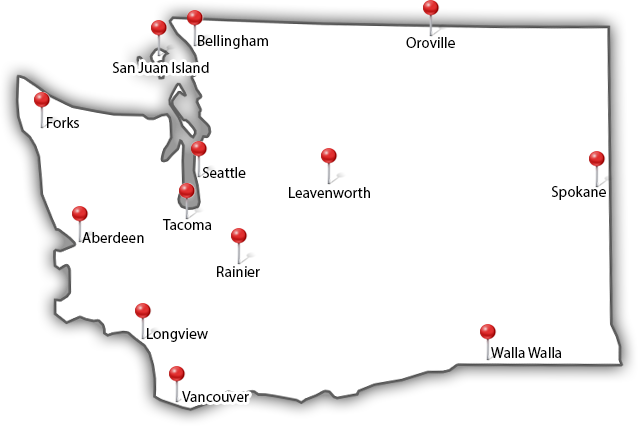How To Spot Tree Hazards and What To Do About Them
Trees are a very fascinating and strong organisms in many respects. They can withstand hurricane force winds, freezing temperatures, and even prolonged drought.
Yet a tree can be greatly affected by even the slightest change. You can read our previous post, Why Is My Tree Dying?, to learn about how overwatering, improper transplanting, and even slight changes in the soil can injure and even kill a tree.
When a tree is affected by certain ailments and is in close proximity to cars, property, and people, it can become a serious hazard.
Keep reading to learn some of the most common tree hazards to look out for, as well as what you can do to help protect yourself and your property from tree damage.
First, let’s learn what defines a hazardous tree.
 What Makes a Tree Hazardous
What Makes a Tree Hazardous
The USDA Forest Service defines a “hazard tree” as “a tree with structural defects likely to cause failure of all or part of the tree.” But a tree does not truly become a hazard until it threatens the safety of a person, property, roadway, or location where people gather like a park, pathway, or backyard.
If a tree is located in a forest or habitat preserve, it is natural for a tree to slowly degrade and eventually fall.
It is when a tree is posing an immediate threat to people, property, or public spaces that it should be considered a ‘hazard tree’ and dealt with appropriately.
Tree Hazards To Look For
There are several common warning signs for a hazard tree. While some are easier to spot than others, it is likely that a hazard tree will show one or more of the following signs.
Dead Wood
Dead branches and sections of a tree are hazards that should be dealt with promptly. Dead wood can be dislodged by wind, animals, or just fall unexpectedly and cause extensive harm to whatever it falls upon.
When a dead branch separates from the tree but is caught in the canopy, it is often called a “widowmaker.” These are at a very high risk to fall unexpectedly on something or someone.
Dead branches should be trimmed or removed as soon as possible to prevent any damage from falling.
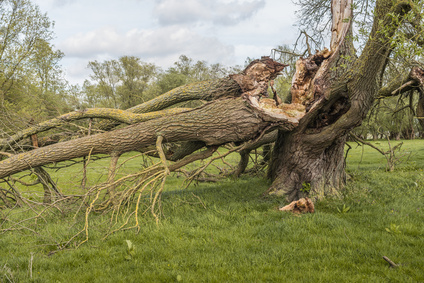 Cracks
Cracks
Some species of trees, like Douglas Fir, develop cracks naturally. But usually when you notice cracks or split wood on your tree, it may be a sign of failing tree health.
Depending upon how large the tree and how serious the crack, cabling may be an option, or you may be forced to remove the entire tree. Especially if the crack extends deep within or completely through the trunk.
Weak Branch Unions
A weak branch connection can occur naturally or due to improper pruning. You can identify a weak union when there is bark that is growing into and between to connected branches.
This is especially hazardous if the weak union is between two main branches or is leading to cracking between the two affected branches.
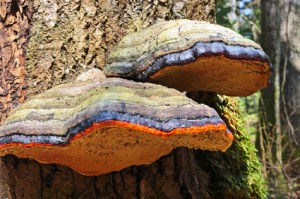 Decay
Decay
Sometimes trees can experience small amounts of rot and decay and still remain healthy and strong. However, when you notice that the tree is beginning to feel spongy, crumbly, or growing a cavity, you may need to remove the tree. Other signs of tree decay are mushrooms or brackets growing on the trunk, flare, or exposed roots of a tree.
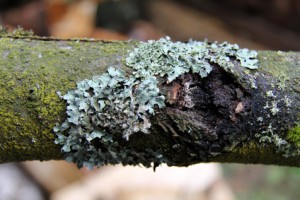 Cankers
Cankers
Cankers are open sores or dead tissues on the outside of a tree. While the presence of cankers may not spell the end for your tree, if a canker grows large enough that it affects “more than half of the tree’s circumference” or is connected with a crack or cavity, you should thoroughly inspect your tree.
Root Problems
While it may be difficult to detect root problems that are located underground, there are certain activities that can be closely related with root damages in a tree.
Severing roots when installing irrigation lines or sewers can greatly decrease a tree’s stability and even lead to tree death. Paving concrete over tree roots can cut off oxygen and nutrient supply and in turn affect the tree’s roots and overall stability. Parking vehicles or equipment on tree roots can compact soil and injure roots. Also, simply changing to the soil grade more that 2-3 inches can injure tree roots.
Generally when a tree becomes unstable, you can notice mounds or bulging in the soil at the base of tree indicating the displacement of soil caused by the leaning of a tree. This is an important indicator that your tree needs corrective help or removal soon.
So what corrective actions can you take to secure or save a tree that may be at risk of failing?
Corrective Measures
Tree pruning and removing any problem sections or branches can easily eliminate the problem, especially when the rest of the tree is sound.
Move the property at risk. If the vehicle, structure, or property can be easily moved from the area in danger, you can ensure its safety without removing the tree.
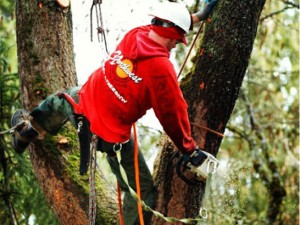 Cabling or bracing a tree won’t fix the tree’s health issues, but may extend the life of a tree. Cabling a tree involves adding a steel or synthetic cable that actually wraps around a tree and its branches, securing them together and providing a failsafe in case part of that tree fails. A brace is used when a tree is split or cracking. You brace a tree by actually drilling a hole through the entire width of the affected area, inserting a steel rod, and syncing up the tree on both ends of the rod to clamp the two separate pieces together. Cabling and bracing are very complicated and difficult techniques that should only be undertaken by a trained ISA-certified arborist.
Cabling or bracing a tree won’t fix the tree’s health issues, but may extend the life of a tree. Cabling a tree involves adding a steel or synthetic cable that actually wraps around a tree and its branches, securing them together and providing a failsafe in case part of that tree fails. A brace is used when a tree is split or cracking. You brace a tree by actually drilling a hole through the entire width of the affected area, inserting a steel rod, and syncing up the tree on both ends of the rod to clamp the two separate pieces together. Cabling and bracing are very complicated and difficult techniques that should only be undertaken by a trained ISA-certified arborist.
Tree removal should always be the last resort. Removing trees can be dangerous and even reduce the value of your property. Make sure that if you decide to remove your tree, you hire a certified arborist who can get the job done safely without affecting any trees or property surrounding the tree.
Have you ever had experiences of hazardous branches or trees falling on your property? Please tell us about your experience in the comments section.
Sources:
- U.S. Forest Service – Identifying Tree Hazards
- Wikipedia – What Is a Canker?
- How to Recognize and Prevent Tree Hazards






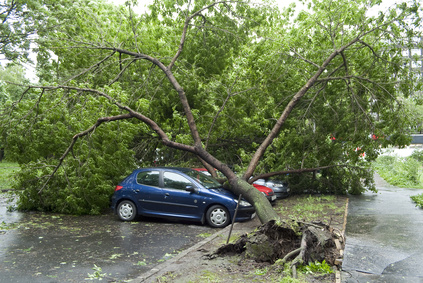 What Makes a Tree Hazardous
What Makes a Tree Hazardous
